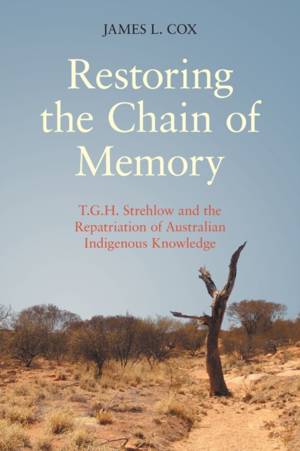
- Afhalen na 1 uur in een winkel met voorraad
- Gratis thuislevering in België vanaf € 30
- Ruim aanbod met 7 miljoen producten
- Afhalen na 1 uur in een winkel met voorraad
- Gratis thuislevering in België vanaf € 30
- Ruim aanbod met 7 miljoen producten
Zoeken
Restoring the Chain of Memory
T.G.H. Strehlow and the Repatriation of Australian Indigenous Knowledge
James L Cox
Paperback | Engels
€ 48,45
+ 96 punten
Uitvoering
Omschrijving
This book describes and analyses the writings and records compiled by the notable linguist, T.G.H. Strehlow (1908-1978), on Australian Aboriginal religions, particularly as practised by the Arrernte of the central desert region. During numerous research trips between 1932 and 1966, the local Indigenous Arrernte Elders entrusted him with sacred objects, allowed him to film their secret rituals and record their songs, partly because he was regarded as one of them, an 'insider', who they believed would help preserve their ancient traditions in the face of threats posed by outside forces. Strehlow characterised Arrernte society as 'personal monototemism in a polytotemic community'. This concept provides an important insight into understanding how Arrernte society was traditionally organised and how the societal structure was re-enforced by carefully organised rituals. Strehlow's research into this complex societal system is here examined both in terms of its meaning and current application and with reference to how the societal structure traditionally was interwoven into religious understandings of the world. It exemplifies precisely how the 'insider-outsider' problem is embodied in one individual: he was accepted by the Arrernte people as an insider who used this knowledge to interpret Arrernte culture for non-Indigenous audiences (outsiders). The volume documents how Strehlow's works are contributing to the current repatriation by Australian Aboriginal leaders of rituals, ancient songs, meanings associated with sacred objects and genealogies, much of which by the 1950s had been lost through the processes of colonisation, missionary influences and Australian governmental interference in the lives of Indigenous societies.
Specificaties
Betrokkenen
- Auteur(s):
- Uitgeverij:
Inhoud
- Aantal bladzijden:
- 256
- Taal:
- Engels
Eigenschappen
- Productcode (EAN):
- 9781800503113
- Verschijningsdatum:
- 26/03/2018
- Uitvoering:
- Paperback
- Formaat:
- Trade paperback (VS)
- Afmetingen:
- 156 mm x 234 mm
- Gewicht:
- 426 g

Alleen bij Standaard Boekhandel
+ 96 punten op je klantenkaart van Standaard Boekhandel
Beoordelingen
We publiceren alleen reviews die voldoen aan de voorwaarden voor reviews. Bekijk onze voorwaarden voor reviews.











